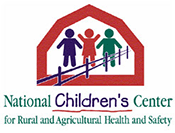 We try to safeguard our homes and farms from potentially dangerous situations, and for the great majority, we have been successful in lowering the total number and percentage of childhood (19 years and under) farm injuries. But, any injury or death that could be prevented is too many.
We try to safeguard our homes and farms from potentially dangerous situations, and for the great majority, we have been successful in lowering the total number and percentage of childhood (19 years and under) farm injuries. But, any injury or death that could be prevented is too many.The National Children's Center for Rural and Agricultural Health and Safety has prepared the 2014 Fact Sheet on Childhood Agricultural Injuries in the U.S. to help better explain the trends in farm safety. Nearly 1 million youth live on farms and half of them work on those farms. Another quarter-million youth who are nonresidents are part of a farm's workforce and this is a growing group.
Every three days a child dies in an ag accident. Machinery is the leading culprit, followed by motor vehicles (including ATVs) and drownings. Vehicles and machinery account for 73 percent of the deaths of youth. Those large pieces of equipment are very unforgiving and all ages should be aware of their potential dangers.
While not fatal, 38 ag-related injuries occur each day in rural America. These might include falls, animals or vehicles. Some may argue that with these dangers, young people should not be working on farms. However, the fact remains that 80 percent of young people injured on farms were not working when injured. (NIOSH 2013) They included such things as recreational horse riding, operating an all-terrain vehicle and falls from structures. A child playing in a field is at similar risk for pesticide poisoning, insect stings or being hit by ag vehicles as a youth working in the field. So, limiting youth working in ag jobs is not the solution.
The number of ag injuries has been declining, but the number of injuries to children under 10 years of age has had the reverse trend. Boys are involved in more farm accidents, but the gap between boys and girls is closing.
While the value of ag injuries is estimated over $1 billion each year and fatalities over $420 million, there is no amount of money that could replace a loved one's life. These calculations heavily weigh "quality adjusted life years" (QALY) using body part affected and the nature of the injury. Falls and transportation incidents resulting in broken bones, fractures and cuts are the main injury causes and they are simple injuries to treat, while machinery and fire/explosions were the cause of most fatalities. In addition to medical costs, value of pain and suffering, rehabilitation, prescriptions and physical therapy were part of the cost of injuries. But, the largest contributor is the value placed on QALY, where the individual's lifestyle has been altered by the accident. Mental health care costs for those involved were not included.
Those who have studied the statistics and made the calculations have been diligent in presenting the information. We, too, should be diligent in trying to prevent the injuries and fatalities … safety barriers around open pits, dangerous chemicals out of the reach of curious youngsters, assigning responsibilities that are age-appropriate, and realistic expectations when small children are under the care of adults busy working. We cannot prevent every incident, but we need to try. If you knew the dangerous outcome ahead of time, what would you have done differently?
 The author is the online media manager and is responsible for the website, webinars and social media. A graduate of Modesto Junior College and Fresno State, she was raised on a California dairy and frequently blogs on youth programs and consumer issues.
The author is the online media manager and is responsible for the website, webinars and social media. A graduate of Modesto Junior College and Fresno State, she was raised on a California dairy and frequently blogs on youth programs and consumer issues.








